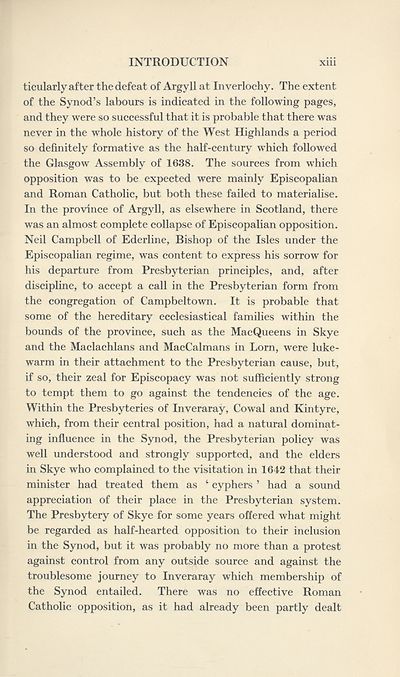Series 3 > Minutes of the Synod of Argyll, 1639-1651 (1652-1661) > 1639-1651
(20) Page xiii
Download files
Complete book:
Individual page:
Thumbnail gallery: Grid view | List view

INTRODUCTION
xiii
ticularly after the defeat of Argyll at Inverlochy. The extent
of the Synod’s labours is indicated in the following pages,
and they were so successful that it is probable that there was
never in the whole history of the West Highlands a period
so definitely formative as the half-century which followed
the Glasgow Assembly of 1638. The sources from which
opposition was to be expected were mainly Episcopalian
and Roman Catholic, but both these failed to materialise.
In the province of Argyll, as elsewhere in Scotland, there
was an almost complete collapse of Episcopalian opposition.
Neil Campbell of Ederline, Bishop of the Isles under the
Episcopalian regime, was content to express his sorrow for
his departure from Presbyterian principles, and, after
discipline, to accept a call in the Presbyterian form from
the congregation of Campbeltown. It is probable that
some of the hereditary ecclesiastical families within the
bounds of the province, such as the MacQueens in Skye
and the Maclachlans and MacCalmans in Lorn, were luke¬
warm in their attachment to the Presbyterian cause, but,
if so, their zeal for Episcopacy was not sufficiently strong
to tempt them to go against the tendencies of the age.
Within the Presbyteries of Inveraray, Cowal and Kintyre,
which, from their central position, had a natural dominat¬
ing influence in the Synod, the Presbyterian policy was
well understood and strongly supported, and the elders
in Skye who complained to the visitation in 1642 that their
minister had treated them as ‘ cyphers ’ had a sound
appreciation of their place in the Presbyterian system.
The Presbytery of Skye for some years offered what might
be regarded as half-hearted opposition to their inclusion
in the Synod, but it was probably no more than a protest
against control from any outside source and against the
troublesome journey to Inveraray which membership of
the Synod entailed. There was no effective Roman
Catholic opposition, as it had already been partly dealt
xiii
ticularly after the defeat of Argyll at Inverlochy. The extent
of the Synod’s labours is indicated in the following pages,
and they were so successful that it is probable that there was
never in the whole history of the West Highlands a period
so definitely formative as the half-century which followed
the Glasgow Assembly of 1638. The sources from which
opposition was to be expected were mainly Episcopalian
and Roman Catholic, but both these failed to materialise.
In the province of Argyll, as elsewhere in Scotland, there
was an almost complete collapse of Episcopalian opposition.
Neil Campbell of Ederline, Bishop of the Isles under the
Episcopalian regime, was content to express his sorrow for
his departure from Presbyterian principles, and, after
discipline, to accept a call in the Presbyterian form from
the congregation of Campbeltown. It is probable that
some of the hereditary ecclesiastical families within the
bounds of the province, such as the MacQueens in Skye
and the Maclachlans and MacCalmans in Lorn, were luke¬
warm in their attachment to the Presbyterian cause, but,
if so, their zeal for Episcopacy was not sufficiently strong
to tempt them to go against the tendencies of the age.
Within the Presbyteries of Inveraray, Cowal and Kintyre,
which, from their central position, had a natural dominat¬
ing influence in the Synod, the Presbyterian policy was
well understood and strongly supported, and the elders
in Skye who complained to the visitation in 1642 that their
minister had treated them as ‘ cyphers ’ had a sound
appreciation of their place in the Presbyterian system.
The Presbytery of Skye for some years offered what might
be regarded as half-hearted opposition to their inclusion
in the Synod, but it was probably no more than a protest
against control from any outside source and against the
troublesome journey to Inveraray which membership of
the Synod entailed. There was no effective Roman
Catholic opposition, as it had already been partly dealt
Set display mode to:
![]() Universal Viewer |
Universal Viewer | ![]() Mirador |
Large image | Transcription
Mirador |
Large image | Transcription
Images and transcriptions on this page, including medium image downloads, may be used under the Creative Commons Attribution 4.0 International Licence unless otherwise stated. ![]()
| Scottish History Society volumes > Series 3 > Minutes of the Synod of Argyll, 1639-1651 (1652-1661) > 1639-1651 > (20) Page xiii |
|---|
| Permanent URL | https://digital.nls.uk/126839499 |
|---|
| Shelfmark | SCS.SHS.118 |
|---|---|
| Attribution and copyright: |
|
| Description | Edited by Duncan C. MacTavish. |
|---|---|
| Shelfmark | SCS.SHS.118-119 |
| Additional NLS resources: | |
| Attribution and copyright: |
|
|---|
| Description | Over 180 volumes, published by the Scottish History Society, containing original sources on Scotland's history and people. With a wide range of subjects, the books collectively cover all periods from the 12th to 20th centuries, and reflect changing trends in Scottish history. Sources are accompanied by scholarly interpretation, references and bibliographies. Volumes are usually published annually, and more digitised volumes will be added as they become available. |
|---|


